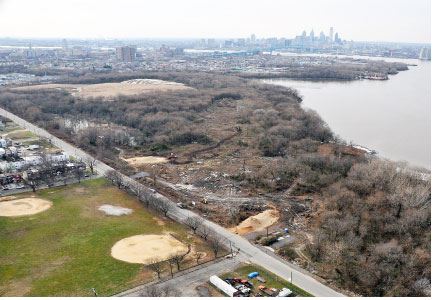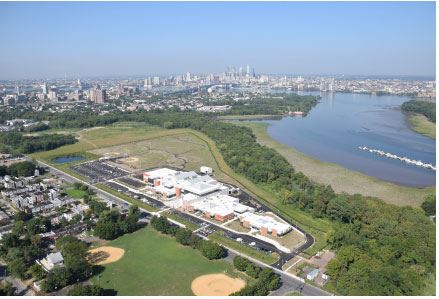by Geoffrey R Forrest PG CPEng LSRP, Dresdner Robin
Highlights
The Ray and Joan Kroc Corps Community Center has been the recipient of numerous community and Agency awards since its opening in October 2014. The project has successfully incorporated many desirous environmental, community, sustainability and energy efficient features and these components have been locally and nationally recognized by the following awards:
- New Jersey Future Smart Growth Award (2014)
- ULI Willard G. “Bill” Rouse III Awards for Excellence (2015 Finalist)
- New Jersey Governor’s Conference Award for Leading Public Private Economic Development Partnership (2015)
- USEPA Region 2 Phoenix Award [Brownfield Redevelopment] (2015)
Background
The Salvation Army Kroc Corps Community Center of Camden, NJ opened in October 2014 in a city that is perhaps best known for its struggles with violent crime and urban decay. Approximately 45% of families in Camden live below the poverty line, and the unemployment rate as of August 2013 was 16.6%, nearly double the national average. Some of the problems of concentrated neighborhood poverty often include high unemployment rates, rampant crime, health disparities, inadequate early care and education, struggling schools, and disinvestment. Though poverty often spans generations, the creation of a safe gathering place in the community for learning, exercising, worship, and community-building, can provide “a beacon of hope and an agent of change”.
Conception
In January 2004, The Salvation Army USA announced that it would be receiving nearly $1.6 billion from the estate of Mrs. Joan Kroc, (whose husband founded McDonald’s), to establish community centers similar to the one Mrs. Kroc established in San Diego. Following a competitive, nationwide-wide proposal process, The Salvation Army regional office in the City of Camden received an award of $59 million of funding. By forging new relationships in the community and partnering with corporate sponsors and political leaders, The Salvation Army was able to secure an additional $31 million to complete the project.
Camden officials and The Salvation Army representatives chose to locate the community center on a portion of the former Harrison Avenue Landfill site at the confluence of the Delaware and Cooper rivers in the Cramer Hill section of the city. This site was chosen in particular because it was large enough to accommodate the project, was owned by the Camden Redevelopment Agency, and was located along bus routes and a proposed rail station allowing for easy access. The location is also in close proximity to the 12,000 children who reside in Cramer Hill and North Camden.
Before Remediation (January 2012)

Environmental Remediation
The Harrison Avenue Landfill is a former 85-acre landfill that was owned and operated by the City of Camden from 1952 to 1971. The landfill,which is now owned by the CRA, is located on the northwest corner of Harrison Avenue and East State Street in the Cramer Hill neighborhood. The landfill is located within the Cramer Hill Brownfield Development Area, which is a voluntary designation between local stakeholders, city officials and NJDEP to expedite the reuse of brownfield sites that border a 2-mile stretch of the Delaware River.
The reclamation of the 24-acre portion of the landfill into the Kroc Center was made possible after several phases of remediation. In September 2008, NJDEP completed a $4.1 million publicly-funded cleanup which removed approximately 14,000 tons of industrial waste materials placed under Municipal Solid Waste (MSW) in a one-half acre area of the southeastern portion of the landfill where the Kroc Center was originally planned. Beginning December 2010 until May 2011, the relocated Kroc Center site was prepared for remediation and received 221,000 cubic yards of Delaware River channel material (“clean fill”) from the Palmyra Nature Cove for use as building foundation and capping of landscaped areas. From December 2011 until February 20 13, MSW was relocated away from the building footprint area and the capping material from Palmyra was placed under the building foundation and over the Kroc campus landscaped areas where the MSW was relocated. From February 2013, most of the activity at the site involved construction–related activities with the foundation of the building being poured and steel framing erected. The remaining remediation work, surficial landscaping and final top cover, was completed before the Kroc Center opened in October 2014.
By initiating the remediation of the Harrison Avenue Landfill, the development of the Kroc center enhanced nearly 100 acres of vital, waterfront land. Additionally, the RJKCCC project includes open spaces with ball fields, walking paths and connections to the future waterfront nature trails. Diverting roof stormwater to existing wetlands adjacent to the project site is designed to enhance them by keeping them recharged. A 300-foot buffer to the river has been kept in tack for Bald Eagle foraging.
After Completion (October 2014)

RJKCCC Facility Details
The Center itself is 120,000 square feet, nearly 3 football fields in length, and provides recreational, health, educational, cultural, family and spiritual programming for area residents. It also serves as the hub for The Salvation Army services in the tri-county region. The amenity-laden facility includes both indoor and outdoor recreational spaces and the facility serves as many as 360,000 members and visitors per year.
The indoor program is divided into three areas meant to serve the Mind, Body and Spirit. The Fitness space includes and 11,000 square foot gymnasium with spectator seating, an aquatic center with 8-lane competition pool and an associated indoor water park, an exercise center with dance studios, a thirty feet high rock climbing wall and comprehensive locker room spaces with showers and dressing rooms. There are social gathering places for teens and youths, a senior center, drop-in babysitting, a 200 seat performing arts center, and a 250 seat chapel. Available social services will include a family life and personal development center, classrooms, art room, computer lab, music room, library learning center, a commercial kitchen, an early childhood education center servicing 90 preschool children and a health clinic run by Cooper Hospital. All of these are separate spaces connected via an 8,000 square feet indoor “Town Plaza” gathering space and café, situated beneath a spectacular glass skylight.
While The Salvation Army is not proceeding with a LEED application, the project has been designed with abundant sustainability elements, enough to achieve a Gold Rating should they so desire. Sustainable features include brownfield redevelopment, aquifer recharging with constructed wetlands and bio-swales, daylighting internal spaces, regional available materials, white roofing to reduce heat island effect, high-efficiency pool filtration systems that reduce annual water and energy consumption, Energy Recovery HVAC systems, recycled content in building materials, efficient lighting, waste steam separation, and recycling.

